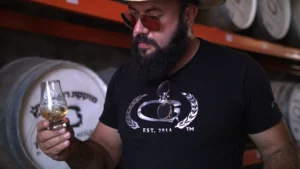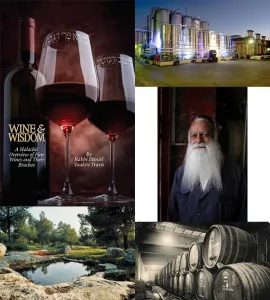There is nothing new under the sun in winemaking. When at Carmel’s Zichron Ya’acov Wine Cellars, I would pass the large barrels on display, and explain that “they were used to ferment the wine 125 years ago.”
In fact, it was so hot in July and August in 1890, pre electricity, that they had to import a special ice machine from Cairo, and large blocks of ice were lowered in bags into the barrels to reduce temperatures during fermentation.
In about the 1920’s, when Soleh Boneh was founded, cement tanks replaced the large barrels because they gave more capacity. Originally they did not line the cement tanks, and the wine became tainted and had to be poured away. Then the cement tanks were lined with glass. Think how expensive that must have been.
Twelve years ago I would show these cement tanks as museum pieces explaining “this is how we used to make the wine.” Fast forward to today. Big barrels are back in. Carmel Winery has introduced a fleet of new fourdres (5,000 liter barrels) into its cellars. These provide gentle oxidization, without imparting too much oak flavors.
Likewise cement tanks. The new winemaker liked the results of wine stored in cement tanks. The wine drops bright better in cement than in stainless steel, it is good for temperature retention and the cement produces an oxidation mid-point between an inert stainless steel tank and a small oak barrel.
So a number of small Italians, were employed from a company specializing in revitalizing cement tanks, to restore the cement tanks one by one. Today they are lined with epoxy and used with pride. Cement is back in throughout the world. Who said progress is only looking forward & not looking back
However large barrels and cement tanks is looking back in years counting in the hundreds. This pales into insignificance when you compare making wine in Kvevri . These are large oval, egg shaped earthenware vessels used for fermenting and storing wine. They were used for winemaking up to 8,000 years ago. Later the Greeks and Romans called them pithos and dolium respectively.
They are enormous containers, made from terra cotta, red clay, which are fired in an open fire. They are sometimes larger than a person, and always handmade, so each will vary slightly in shape. Kvevri are used again and again. Some in Georgia go back centuries. They should not be confused with amphorae which were used later, more for storage and transportation.
Hugh Johnson relates in his ‘The Story of Wine’, how in Georgia, you would visit a family winery and the family would have a private cellar, yet there were no out buildings housing barrels or tanks. The only clue was a series of molehills in the ground nearby where these large containers were buried.
He writes that the family would hollow out a log, slop the grapes from a harvest into it and stamp on the grapes until all the must or juice had been released. Then the juice, grape skins, pips and all, would be scooped up and placed in these massive containers, stoppered up and buried deep in the soil.
The temperature of the ground would be cool, and the wine slowly fermented over a long period. In the spring the family would ladle the wine out into another Kvrevi, this time leaving the skins behind and the wine was stored this way until it was drunk.
Delightfully there are still families making wine this way in Georgia and some modern winemakers in Friuli, Slovenia and Georgia, believing in tradition, nature and retro, have also returned to making wines this way.
Why not in Israel I hear you ask Well, one enterprising family has introduced Kvevri to Israel. This was under the direction of Lina Slutzkin who founded her Kadma winery in Kfar Uriah in the Judean foothills in 2010.
She was an engineer who worked for Intel for twenty years. The Slutzkins then bought a farm and she got an itch and decided to do something completely different.
She wanted a winery, but was determined to be different from everyone else. She sought encouragement, but most people lacked her imagination and thought she was crazy. One encouraging beacon was Nir Shoham, owner of the Soreq Winery Winemaking School. He taught, encouraged and advised her. That was enough to send her on her way.
She had made Aliyah from Georgia as an eight year old girl in 1972, and adopted Israel without feeling the slightest sentimentality to her mother country. She is quite adamant that when she came to Israel, she shrugged off her Georgian past forever. She explained that she did not look back but then said wistfully: “but those who think France has the best cuisine in the world, don’t know Georgia!”
Anyway to make her dream come true, she returned to Georgia for the first time in 36 years and went in search of some Kvevri to bring back to Israel. Making these is an ancient and rare artisanal craft, passed down in families over thousands of years, but it is a declining art.
She had to find the few remote villages where these large containers are still made. That was the easy part. Then she had to pack them safely and ship them to Israel. Drama and no little determination was the order of the day, but, wonder of wonders, they arrived safely.
Unfortunately the soil temperature in Israel was too warm for the Kvevri to be buried in the Holy Land as they are in Georgia, but nothing was to prevent Lina from achieving her aim.
The winery sought advice from winemaker Dr. Arkadi Papikian, one of the leading wine consultants in Israel, and Professor Amos Hadas, author of ‘The Vine and Wine in Archaeology of the Land of Israel’. Professor Hadas explained that pottery containers used for fermentation were never buried in the soil in Ancient Israel.
Eventually they decided to stand the earthenware vessels in a cold storage room. Cold maceration, fermentation and malolactic fermentation all take place within these containers making them the only winery in Israel that makes wine in this way. Then the wines are aged in oak barrels in the usual way.
Lina explained that they wanted to combine these ancient vessels with modern techniques to make wine in a country with such an ancient winemaking history.
The benefits of the Kvevri are that fermentation is longer and more even and the narrow conical base means less prolonged contact between lees (sediment) and wine. It is moving and exciting to see these vessels of winemaking history in use here in Israel. Well worth a special visit.
Another reason is to taste the cheeses, cut vegetables and the delicious Georgian paste from a secret recipe and the scrumptious bread baked by Reuven Grafton, a local baker. You need another reason Maybe it is to meet Vlad, Lina’s husband from St. Petersberg. He is a fascinating walking encyclopedia of wine information from ancient history until today. Unfortunately he works in Hi tec by day, but if you can catch him helping out on his days off, you are the winner.
Future dreams Maybe, to bring the Georgian variety Separavi, to Israel, to ferment in her Kvevri. Now that would be interesting!
Modern winemaking technology here may give the impression Israel is in the New World of winemaking. The return of cement tanks and large barrels reminds us of our Old World roots. However Slutzkin’s Kvevri, the discovery of a very large 3,600 old wine cellar at Tel Kabri in the Galilee and the hundreds of old limestone wine presses that decorate our landscape, help to remind us that our true beginnings are in the Ancient World. It seems what goes around, comes around.
The wines I tasted were as follows:
Kadma Chenin Blanc 2014
A white wine with a blowsy, tropical fruit aroma. Its sweetness is quite apparent, but is offset somewhat by a clean finish. It will be popular amongst those who like semi dry wines. Price: 90 ILS
Kadma Gemino 2013
This was my favorite wine, made from a blend of Sangiovese and Merlot. It has a cherry berry aroma with an earthy, peppery backdrop. It has medium weight, with a refreshing finish.
Price 70 ILS
Lirae Kadma 2013
A blend of Cabernet Sauvignon and Merlot, with aromas of blackcurrant and ripe plum. It has a full flavor with a vanilla coating.
Price: 80 ILS
Copia 2013
A blend of Cabernet Sauvignon, Merlot and Sangiovese. The wine is full bodied, fruity with black fruit dominant and exhibits a certain mouth filling complexity. Good finish.


















